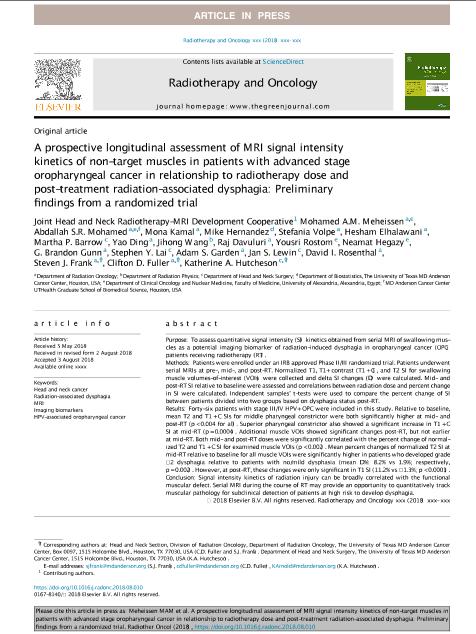A prospective longitudinal assessment of MRI signal intensity kinetics of non-target muscles in patients with advanced stage oropharyngeal cancer in relationship to radiotherapy dose and post-treatment radiation-associated dysphagia: Preliminary findings from a randomized trial
摘要:Abstract Purpose To assess quantitative signal intensity (SI) kinetics obtained from serial MRI of swallowing muscles as a potential imaging biomarker of radiation-induced dysphagia in oropharyngeal cancer (OPC) patients receiving radiotherapy (RT). Methods Patients were enrolled under an IRB approved Phase II/III randomized trial. Patients underwent serial MRIs at pre-, mid-, and post-RT. Normalized T1, T1+ contrast (T1 + C), and T2 SI for swallowing muscle volumes-of-interest (VOIs) were collected and delta SI changes (Δ) were calculated. Mid- and post-RT SI relative to baseline were assessed and correlations between radiation dose and percent change in SI were calculated. Independent samples’ t-tests were used to compare the percent change of SI between patients divided into two groups based on dysphagia status post-RT. Results Forty-six patients with stage III/IV HPV+ OPC were included in this study. Relative to baseline, mean T2 and T1 + C SIs for middle pharyngeal constrictor were both significantly higher at mid- and post-RT (p < 0.004 for all). Superior pharyngeal constrictor also showed a significant increase in T1 + C SI at mid-RT (p = 0.0004). Additional muscle VOIs showed significant changes post-RT, but not earlier at mid-RT. Both mid- and post-RT doses were significantly correlated with the percent change of normalized T2 and T1 + C SI for examined muscle VOIs (p < 0.002). Mean percent changes of normalized T2 SI at mid-RT relative to baseline for all muscle VOIs were significantly higher in patients who developed grade ≥2 dysphagia relative to patients with no/mild dysphasia (mean Δ%: 8.2% vs 1.9%; respectively, p = 0.002). However, at post-RT, these changes were only significant in T1 SI (11.2% vs −1.3%; p < 0.0001). Conclusion Signal intensity kinetics of radiation injury can be broadly correlated with the functional muscular defect. Serial MRI during the course of RT may provide an opportunity to quantitatively track muscular pathology for subclinical detection of patients at high risk to develop dysphagia.
关键词:
论文方向:[{"id":912,"name":"肿瘤学"}]
发表期刊:Radiotherapy and Oncology
发表时间:Sat Sep 08 00:00:00 CST 2018
数字识别码:10.1016/j.radonc.2018.08.010
是否作者本人: 否
版权及免责声明:
本网站所有论文文件均系用户自行上传或提供,本网站对其内容准确性及合法性概不负责,亦不承担任何法律责任。论文版权归原作者及原出处所有。
如您发现网站其他用户上传的论文有侵犯您的姓名权、隐私权、著作权或其他合法权益现象的,请及时与本网站联系并附加相关权利证明文件,以便本网站及时作出处理,维护您的合法权益。
本网站拥有对此声明的最终解释权。






{replyUser1} 回复 {replyUser2}:{content}